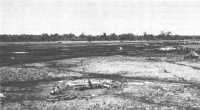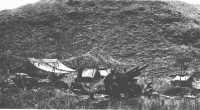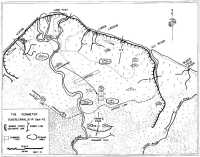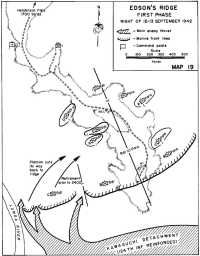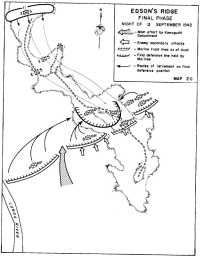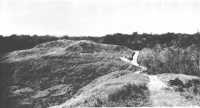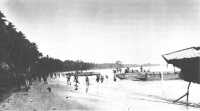Chapter 5: The Battle of the Ridge
General Vandegrift and his staff were aware that the defeat of the Ichiki Force left the division’s position on the island only temporarily improved. Obviously the Japanese could be expected to mount larger and better planned attacks against the small Marine perimeter; air and naval activity at Guadalcanal indicated no waning enemy interest in the South Solomons area. A noon-hour visit from Rabaul bombers was an almost daily occurrence, and enemy warships and submarines entered Sealark Channel nearly every night to shell Henderson Field.
Although the Battle of the Eastern Solomons gave Allied shipping from Espiritu Santo an opportunity to increase the flow of supplies to the beleaguered Marines, the Lunga defenders still operated on a hand-to-mouth basis.
The Cactus Air Force performed beyond all proportion to its facilities and equipment, and the 3rd Defense Battalion finally was able late in August to bring in the 5-inch guns of its two seacoast batteries; but there were not enough marines on the island to enlarge the perimeter for an adequate defense. General Vandegrift believed that positions along 45 miles of Guadalcanal’s north coast would have to be held before the Japanese could be restrained from landing and attacking Henderson Field and before air defenses would have sufficient room for deployment. The general did not have that kind of manpower.
Since Major John Smith and Lieutenant Colonel Mangrum arrived with their F4Fs and SBDs on 20 August, the airfield had taken on a more proficient and permanent look. By the end of August a daily routine of scheduled patrol flights had been initiated. Four-plane fighter patrols flew from 0545 to 0830 each morning and from 1400 to 1830 each afternoon, and mixed fighter-bomber squadrons frequently made night searches for enemy shipping to the northwest. Cactus aviators flew cover for the Allied shipping to the island, and went up on intercept during the Japanese raids.
The U.S. fighters did well against the enemy bombers, but their only chance against the highly maneuverable Zero was to pair up in mutual support. In this way they could protect themselves when the Zeros came down to drive them away from the bombers. They found that the Grumman did have certain advantages over the Zero, however. It had great fire power, and it could stay in the air with more holes in it than the more flimsy Japanese fighter could endure. During the first ten days of Cactus operations, U.S. fliers shot down 56 Japanese planes at a cost of 11 of their own craft.
Marine engineers rigged a system of lights from captured Japanese equipment to outline the field for emergency night landings. and, when dump trucks and pneumatic tampers came in later, workers could fill a 500-kilogram-bomb crater in 30
minutes. Dump trucks were kept loaded with gravel and sand, and “flying squads” of engineers rushed out to repair any damage immediately after the departure of Japanese bombers.
But not even counting enemy action, Henderson personnel still had plenty of problems. An early method of fueling employed drums strung up in the rafters of partially built Japanese hangars, and even when gasoline trucks arrived later the fuel had to be hand pumped from drums to the trucks. There was no steel matting. and the field was completely at the mercy of the whimsical tropical weather:–
Henderson Field was a bowl of black dust which fouled airplane engines or it was a quagmire of black mud which made the take-off resemble nothing more than a fly trying to rise from a runway of molasses.1
When engineers and Seabees had no bomb craters to patch, they still had to fix up the field in the wake of the early SBDs which had hard-rubber tail wheels designed for landing on the sturdy decks of carriers. On the Henderson earth these wheels “... chewed up the runway like a plowshare.”2 The sorry condition of the field added serious operational losses to the troubles of the small Cactus force which was nearly always outnumbered in the air. Occasionally a plane was gripped so persistently by the mud that it failed to take off and crashed at the end of the runway; ruts and the beginnings of potholes were hazards on dry days, and on one foggy wet afternoon in early September a landing F4F crashed into a bulldozer.
But in spite of everything the installation grew and slowly improved, and this was a period when American fighting men were thankful for small favors. On 20 August the transport William Ward Burrows came up from the New Hebrides with the forward echelon of MAG-23. All the men and some of the gear were put ashore, but then the ship scurried across Sealark Channel for Tulagi when the word came in that a Japanese cruiser force was expected that night. Near Tulagi the transport went aground and much of the equipment still on board had to be jettisoned to float her free.
Next day Colonel William J. Wallace, group commander, came up to Henderson with more planes; 19 F4Fs of Major Robert E. Galer’s VMF-224, and 12 SBD-3s of VMSB-231 commanded by Major Leo R. Smith. That brought the Cactus strength to 86 pilots and 64 planes, 10 of them Navy and three Army.
On 1 September the ground crews got more help. Five officers and 387 men of the 6th Naval Construction Battalion {Seabees) landed with two bulldozers. They would “... help make an airfield out of Henderson and ... clear a short grassy strip a mile to the east called Fighter 1.”3 But next day came one of the infamous Henderson disasters that always loomed as a threat to much of the backbreaking effort that had gone before.
With the frequent raids, fire was always a dangerous possibility, and a field fire brigade had been organized around two Japanese trucks which had been repaired by the 1st Marines. They got their baptism on 2 September when a bomb from a heavy Japanese raid hit an armed SBD parked at the edge of a coconut grove where ammunition was stored. The bomb could not be removed from the burning
90-mm antiaircraft guns of the 3rd Defense Battalion point skyward at Henderson Field on alert against the attacks of Japanese bombers. (USMC 61608)
105-mm howitzer of the 11th Marines nestles beneath the slope of a protecting ridge on Guadalcanal ready to go into action against the Japanese. (USMC 51832)
SBD. and when it exploded it spewed flaming gasoline in all directions. One 90-mm shell dump was ignited, and the fire brigade could not do its best work with all the explosions that resulted. Several of the fire-fighters were injured, and the trucks seemed to be making little headway since they had to take turns dashing off to the Lunga River, the closest supply of water. If the fire expanded much more it would set off a chain reaction and all the ammunition in the area would be lost.
Had not the situation been so grim, some old hands might have been reminded of the Chinese fire drill of ancient Marine legend. The blaze was eventually brought under control, however, and the loss was serious but not critical. After this, large water tanks from coconut plantations were spotted around the ammunition dumps; but this fire proved to be the most serious of the campaign. Subsequent losses occurred in division dumps as a result of naval shelling at night. These losses were negligible since the ammunition by that time had been buried.
This bombing raid had arrived at 1135, and while the fire department below worked to save the ammunition dumps, Cactus fliers were up among the bombers. They shot down three of the twin-engined craft and four Zeros without a single loss of their own.
On 3 September the command echelon of the 1st Marine Aircraft Wing arrived. This group included Brigadier General Roy S. Geiger, commanding general of the wing; his chief of staff, Colonel Louis E. Woods; and Lieutenant Colonel John C. Munn, wing intelligence officer. Using the MAG-23 staff as his wing staff, Geiger established his command post near that of General Vandegrift. Liaison in the form of daily conferences between the two generals was established, and Kenneth H. Weir, now a lieutenant colonel, at last had a well-organized air headquarters with which to deal as division air officer.4
Fueling and arming of the planes continued in a make-shift manner for some time, and as late as November bombs had to be manhandled. Radio communications likewise posed problems. Army and Navy receiving channels did not mesh, and the Army planes of the Cactus Force could not receive Navy traffic. Operations resolved this by employing the radio from a grounded Army P-400 alongside the Navy set and thereafter making simultaneous broadcasts over twin microphones. This was a big help, but communications still were far from satisfactory. Beyond 20 miles the planes could not depend on receiving the field, but the field could normally read the planes’ messages from as far as 100 miles.
Since the fight against Ichiki, there had been little opportunity for close air support of ground troops, but Marines continued to plan for this sort of air-ground teamwork. Communications was the big problem here, too. At that stage of operations only visual signals were used, consisting mainly of colored panels which the ground troops had, but they left much to be desired. Planes now flew higher and faster than they had in the banana wars and maneuvers, and this made it more difficult for pilots to read the panel messages, even if they could catch a glimpse of the colored markings. And more often than not in Guadalcanal’s thick jungle and tall grass, they could not even see them. Guadalcanal Marines had heard about colored smoke grenades which were being tested back in the States, and they thought these
might be helpful for air-ground signals. But what they really had their eyes out for were some radio sets. That seemed to be the only promising solution for air-ground coordination. Radios initially available to the division would not serve the purpose, and it would not be until October that Vandegrift could detail an officer and suitable radio equipment and personnel to train as “air forward observers” from each infantry regiment and thereby pioneer in what later became an important phase of Marine combat operations.
While Geiger built up his air arm, Vandegrift likewise added strength to the Lunga perimeter. With Tulagi quiet, he brought some of General Rupertus’ troops across the channel to Guadalcanal. The 2nd Battalion, 5th Marines made the move on 21 August, and the 1st Raider Battalion and the 1st Parachute Battalion crossed to he Guadalcanal side on 31 August. In early September, when a detachment of the 5th Defense Battalion came ashore at Tulagi, a 90-mm battery of the 3rd Defense Battalion joined it parent organization in the Henderson Field area.
From all indications these additional troops would be needed. Aerial observation and native scouts piled up reports of Japanese landings on both sides of the perimeter, and staff officers estimated a build-up of some 200 or 300 well-equipped enemy troops near the village of Tasimboko some 18 miles east of Lunga Point. Native scouts placed the enemy strength much higher, but Marines suspected such counts to be exaggerated.
Patrolling continued in all sectors, and on 27 August the 1st Battalion, 5th Marines under Lieutenant Colonel William E. Maxwell met a strong body of troops near the village of Kokumbona, west of the perimeter. The battalion had made an amphibious landing without incident at about 09730, but later ran into the Japanese force dug into positions throughout a narrow coastal gorge. Maxwell was beyond artillery range of the perimeter, and although the 2nd and 5th Battalions of the 11 Marines fired diversionary missions east of him in Matanikau village, the Japanese facing the infantry Marines seemed inclined for once to make a strong stand rather than to slink off into the brush as they had frequently done in other such engagement.
Faulty communications and other difficulties bogged the Marine attack, and Lieutenant Colonel Maxwell withdrew his force to comply with a portion of his patrol order which required him to return to the perimeter by nightfall. But the regimental commander, Colonel Hunt, ordered the battalion back into the fight, relieved Maxwell of command, and soon thereafter arrived on the scene himself. Major Milton V. O’Connell succeeded to command of the battalion, but the attack was not resumed until the predawn hours of the following morning. A few Japanese were killed, but most of them had withdrawn. The Marines retired to Matanikau village and later returned by water to the perimeter.
On 2 September two companies of the raider battalion patrolled Savo Island but found no enemy. Following this the raiders and parachutists, consolidated into a provisional battalion, moved into defensive positions on the south rim of the perimeter, inland from the airfield, While they dug in, Colonel Edson and his staff made plans for an amphibious raid to the east where the enemy build-up was reported around the Tasimboko area.
The landing was made just east of Tasimboko before dawn on 8 September,
and the raiders5 advanced west into the rear of the reported Japanese positions. At about 0630 planes of MAG-23 bombed and strafed the suspected strong point, and two destroyer transports, Manley and McKean, opened up on the area. At 0830 Edson made contact against light resistance, and his advance overran two artillery pieces. He still could not determine the strength of the enemy, but the force appeared to be withdrawing toward the village, and he requested that supporting drive bombers remain on station in the event that the enemy pocket could be localized for an air strike. General Vandegrift ordered ten planes to remain in continuous support and placed another squadron to call to Edson.
By 1045 to resistance had stiffened, and the raiders requested that more troops land to the west of the village and support their attack. Not wanting to weaken the perimeter, division replied that such a move was not feasible. Vandegrift suggested that the raiding force reembark and return to the perimeter if the Japanese proved too strong to handle. Edson remained, however, and 45 minutes later had overrun more artillery pieces as the battalion advanced slowly against a heavy volume of fire. The colonel estimated the enemy as about 1,000 well-armed and well-equipped troops, and the force now seemed inclined to make a stand. Portions of Edson’s advance drew fire from field artillery at point-blank range.
Some of the raider units had lost internal contact during the stiffening battle, but these faults were corrected at about 1100, approximately the same time that the parachute battalion reported to Edson, and the commander decided to make a coordinated attack against the firm opposition. The colonel called in a P-400 strafing attack and then followed this with an envelopment inland by his raiders while the parachutists protected his flank and rear. The assault carried the village, but again the Japanese had elected to break contact and prepare for an attack at a time and place of their own choosing.
The village was deserted, but the appearance of the abandoned encampment indicated that reports of native scouts had been most accurate. Edson estimated that some 4,000 Japanese had been in the vicinity until shortly before his attack, that his force had met only outposts and rear guards of a newly arrived unit which obviously was preparing a strong attack on Henderson Field. Twenty-seven Japanese had been killed. Marine casualties numbered two dead and six wounded.
Edson’s estimate of the Japanese strength was a little low, but he was right about the enemy’s intentions. Just as the 1st Marines had previously scouted elements of the Ichiki Force it later met at the mouth of the Ilu River, so Colonel Edson had located the gathering Kawaguchi Force his men would meet later in a bitter stand before the airfield.
Rabaul had kept Admiral Tanaka’s reinforcement ships busy. The admiral had taken over the cruiser Kinugasa to replace his damaged Jintsu, and early on 29 August Admiral Mikawa had ordered Tanaka to begin transporting reinforcements by destroyer. The remnants of Ichiki’s rear echelon would be taken down to Guadalcanal as would the Kawaguchi Force, due to arrive later that day from Truk on board the transport Sado Maru. Tanaka loaded supplies on board the ships of
Map 18: The Perimeter, 12-14 September 1942
Destroyer Division 24, and put the troops of Ichiki’s rear echelon on board two destroyer transports. Then he stood by for the arrival of Kawaguchi.
Kawaguchi’s 35th Brigade, a part of the 18th Division in China, was built around Colonel Akinosuka Oka’s 124th Infantry Regiment. From China the unit had moved in December 1941 to Borneo. In March 1942 it moved to Cebu in the Philippines, and April to Mindanao. and in June to Palau. Alerted for a New Guinea operation that never came off, the force remained in the Palau Islands until late in August when it began to stage in echelons through Truk for the Rabaul area. When it arrived for this new mission it was formed up to include the rear echelon of the 2nd Battalion, 28th Infantry (Ichiki Force), the 124th Infantry, the 2nd Battalion, 4th Infantry, and units of artillery, engineer, signal, and antitank troops. In that form the Kawaguchi Force numbered more than 6,000 men.6
Admiral Tanaka had his destroyers all ready when Kawaguchi arrived. The admiral met immediately with the general to hurry things along, but he ran into difficulty at once. Kawaguchi was a barge man, and he did not care much for this idea of going down to Guadalcanal in destroyers. He had once moved his unit 500 miles by barges to make a distinguished landing on Borneo. Now he wanted to know how it would be if he went on down to Gizo Harbor just north of New Georgia on board his Sado Maru, and then transferred to barges for the remainder of the trip and for the landing at Guadalcanal. Kawaguchi’s subordinate officers nodded agreement to this idea. They were barge men, too. The impatient Tanaka referred this dispute to Mikawa of the Eighth Fleet and Hyakutake of the Seventeenth Army. These officers prevailed upon Kawaguchi to temporarily curb his warm regard for barges. He would make all of the trip on Tanaka’s destroyers, and land on Guadalcanal from them, besides.7
For the build-up on Guadalcanal, Kawaguchi split his command. The general would land in the Tasimboko area with the Ichiki rear echelon and the 1st and 3rd Battalions, 124th Infantry Regiment. Colonel Oka would land with the remainder of the force—the 2nd Battalion, 124th Infantry—west of Lunga Point near Kokumbona. Each of the two forces was reinforced by a share of the artillery, engineers, and other special troops. There was only one hitch in the reinforcement efforts, even if Kawaguchi might have been uneasy without a barge under him, but this bobble had no serious over-all results. Captain Yonosuke Marakami, commanding Destroyer Squadron 24, was to clear the way for the landings by going down The Slot on the night of 29 August to attack a U.S. task force which was reported to be off Lunga Point. Instead, Murakami came steaming back up The Slot for the comfort of the Shortlands. The night sky around Guadalcanal, he explained, was too full of a bright moon and U.S. aircraft. “He was transferred shortly to the homeland,” Tanaka reported later.8 The elements of the Kawaguchi Force landed during the nights of 30 and 31 August, at about midnight in both cases.
In spite of the fact that the commanders were separated by a distance of some 30 miles, Kawaguchi planned a difficult
maneuver that proposed to strike the Lunga perimeter in a three-jawed envelopment from the west, south, and southeast, It was to be a coordinated attack with air and naval support. To the normal problems inherent in such an involved plan, Kawaguchi imposed upon his force the additional task of cutting a trail over the steep jungle-covered ridges and gorges from the Tasimboko area to a point south of Henderson Field. The jungle trail, planned as a route which would enable the Japanese to escape observation, was begun about 2 September by Kawaguchi’s engineers. Infantry, artillery, and other units followed the engineers along this hand-hewn jungle route toward their lines of departure for the attack against the Marines.
The Battle of the Ridge
Kawaguchi’s fade-out into the jungle was successful. He was not spotted by marines again until he was ready to attack, but it soon became apparent to the Lunga defenders that he would have imposing support from Rabaul. Far-ranging intelligence sources reported a Japanese naval build-up in the Truk and Palau areas and greatly increased air activity around the Bismarck Archipelago.
“The situation as I view it is very critical,” Admiral Ghormley messaged Nimitz.9 “Our transportation problem increases steadily as Japs perfect their blockade methods.” Japanese pounding of Guadalcanal picked up; the defenders clearly were being softened up for a big attack, and while the South Pacific scurried to get them more planes the men at Lunga hoped that the field would stay dry for the important day.
On 11 September, the pace of the attacks quickened. Twenty-six bombers and eight Zeros came over at 1210 to pock the field, kill 11 Marines, and wound 17 others, and destroy one O-400 parked beside the strip; and a heavy cruiser and two destroyers were spotted steaming south about 100 miles to the northeast. But on the same day the Cactus Air Force added to its strength. At 1620 a flight of 24 F4Fs that had been idle since their carrier Saratoga had been torpedoed on 31 August came up to Henderson from Espiritu Santo under the command of Lieutenant Commander Leroy C. Simpler. Before noon the next day (12 September) Simpler’s men got their chance to learn Cactus operations. Twenty-one of them went up with 11 “old” Cactus fliers to shoot down 12 bombers and three fighters out of a 42-plane Japanese strike that came over at 1100.
Meanwhile patrols from the 2nd Battalion, 1st Marines began to encounter frequent opposition east and southeast of the perimeter. Native scouts brought word of large bodies of troops that clearly were not wandering remnants of Ichiki’s action. The troops had an air of purpose and direction apparent even to the local natives who began to flee from their villages to the Marine perimeter. By 10 September native reports indicated that the enemy was less than five miles east of the perimeter and that he was cutting a road to the south.
The perimeter by this time had been improved and strengthened. The 1st Marines right (east) flank was refused for some 4,000 yards inland from the mouth of the Ilu, and on the west the 5th Marines, with a strong reserve in the form of its 2nd Battalion just over from Tulagi, refused
its flank inland for approximately half that distance. The space inland between these flanks still posed a serious problem, but it had been partially solved by the establishment of well-prepared strong points and outposts.
Troops from the 1st Amphibian Tractor and Pioneer Battalions maintained positions south (inland) of the 5th Marines sector west of the Lunga, while east of the Lunga a 4,000-yard outpost line was maintained by the 1st Marines, artillerymen, the engineer battalion, the bulk of the pioneer battalion, and the raider-parachute battalion. General Vandegrift had ordered the raiders and parachutists out of division reserve to augment this line by preparing positions on a long low ridge that extended south of Henderson Field and parallel to the Lunga River. The thousand-yard-long ridge was but a mile south of the airfield and, unless well defended, offered the Japanese an inviting avenue of approach to the field.;
The pioneer battalion (minus its company west of the Lunga) held positions just south of Henderson Field between the Lunga and the north spur of the ridge occupied by Edson’s force. Father to the east—and across the ridge spur from the pioneers—was the area of the engineer battalion. Between the two positions was the division command post which recently had been moved from its former, bomb-pocked position near the airfield.
On the 12th, the same day the Saratoga fliers went into business with the Cactus circus, Edson and his executive officers walked out on their ridge to decide on a location for defenses. The officers drew small-arms fire from the jungles to the south, and Edson called up his troops to dig in across the southernmost knoll on the ridge. This was forward of the flanks of the engineers on his left (east) and the pioneers on his right, but Edson wanted to hold all the ground he could and to launch an attack against the enemy the next day.
At about 2100 that night a Japanese light cruiser and three destroyers entered Sealark Channel to shell the airfield, and at about the same time the enemy ground force probed lightly at the raider-parachute force on the ridge. Fighting was sporadic all along the line, and although one desultory Japanese attack actually made a slight penetration of the Marine line, the enemy made no attempt to consolidate or expand this gain.
Early the next morning (the 13th) Edson launched his counteroffensive, but he found the enemy too strong and well-prepared to be thrown back. In the afternoon the Marine officer withdrew his exhausted men north of the positions they had held the previous night and established a stronger line on a higher portion of the ridge closer to the engineers and pioneers to his left and right rear. On the right, in the jungle between the ridge and the Lunga, a sketchy contact was made with the pioneer battalion; on the left (east) the raider-parachute flank dangled open.
While Edson’s force sweated under the hot sun on the grassy ridge, Henderson Field was having more than its share of action. The Japanese raids started at 0950, came back at 1300 and again at 1730. The mixed Guadalcanal force shot down 11 of the enemy planes during the day while losing five of their own number. But again the U.S. air strength grew.
Navy pilots from the Hornet and Wasp brought in 18 F4Fs, and in the afternoon more Saratoga fliers and planes came up
Map 19: Edson’s Ridge
from Espiritu Santo. Nimitz and Ghormley were doing all they could to bolster the Solomons toe hold against the Japanese attack that was coming. Later in the day Lieutenant Commander Louis J. Kirn brought in a flight of 12 SBDs of VS-3 and the field also got its first torpedo planes when Lieutenant Harold H. Larsen, USN, flew in leading six TBFs of VT-8.10 But while the Henderson flying force gained by 60 planes during the period of 11-13 September, Rabaul’s air power jumped an additional 140 planes on 12 September along.
Taking periodic cover from sniping and bombing raids, Edson’s men continued to dig in for one more night on the ridge; on the morning of the 14th they were to be relieved by the 2nd Battalion, 5th Marines. But it looked as if the night would be the worst they had seen yet; scouting planes spotted seven destroyers coming down The Slot, evidently to add their bombardment to the ground attack that appeared shaping up in the jungle to the south.
During the afternoon the reserve battalion (2/5) moved to an assembly area east of the Lunga and between the airfield and Edson’s Ridge, and officers of this battalion had gone forward to Edson’s lines to look over the area they would control the following day. The 105-mm howitzers of the 5th Battalion, 11th Marines lay in direct support of the Edson force, and elements of the special weapons battalion had an observation post on the ridge. It Guadalcanal defense was as ready as it could get.
Edson’s disposition placed his two parachute companies on the exposed left flank and tied them in on the right with raider Company B which held the ridge knoll in the center of the Marine line. Company A of the raiders extended down the west slope of the ridge toward the Lunga and to the makeshift contact with the pioneers. Raider Company C, on a high knoll to the north (rear) of Company B, was Edson’s reserve.
At sunset units were organized in small combat groups of about platoon strength disposed at intervals along the main line of resistance. There were open fields of fire only in the center of the position where the MLR crossed the grassy ridge, but even here the abrupt slopes and broken ground made coordination of fires difficult. In the last hours of daylight the troops improved their foxholes and the fields of fire, but the resulting positions were neither continuous nor complete.
In the first hours of darkness, Louis the Louse, or Washing-Machine Charley,11 chugged over to drop his inconsistent scattering of bombs, and about 2100 he let go a flare that hung over the field as a registration point for the destroyer task force that now opened up from Sealark Channel.
As if in answer, a flare went up from the troops south of Edson, and without artillery preparation Kawaguchi drove a two-battalion attack against the center and right of the raider-parachute line. Company
B’s central sector on the high knoll caught most of this first assault and turned it back, but the other attack column found an opening to the west and came through to cut off and envelop Company B’s right platoon. While the Japanese drove through this gap between Companies A and B, the isolated platoon fought its way back along 250 yards of the ridge to join Company C on the knoll to the north. Still engaged and nearly overpowered, Company B refused its right flank along the ridge’s west slopes.
Edson had been calling in fire from 5/11’s howitzers since the beginning of the attack, and as the Japanese continued to hammer at his men the colonel directed the artillery closer and closer until it was falling within 200 yards of the Company B lines. But still the Japanese came on, and by 2200 Edson estimated that the two understrength parachute companies and Company B (less the withdrawn platoon) were opposed by at least two enemy battalions attacking in full force.
Japanese infiltration parties were taking over some of the Company B foxholes, communication lines were cut throughout the area, and the Japanese now began to drum the ridge with heavy mortar fire. Following a violent barrage at 2230, the Japanese attack shifted to the east where it struck the thin flank held by the parachute troops. Screaming in English, “Gas attack! Gas attack!”, the Japanese came out of the jungle through a smoke screen and drove the parachutists back along the ridge to expose the left flank of Company B.
This left the B Company raiders, now cut to approximately 60 men, exposed on both flanks as well as their front, and Edson called for them to pull back to a last-ditch stand with Company C. Company A would join the force there, and Edson ordered his men to hold at all costs. It was the last dominating terrain feature south of the airfield.
Screening the withdrawal of the two companies with artillery fire, Edson collected his men as they filtered back and built them up in what he hoped would be a line strong enough to make the final stand. The colonel and his officers ironed out the confusion of setting in the new defense in darkness and under fire while holding off repeated Japanese assaults. In all, the enemy struck more than a dozen times throughout the night, the Kawaguchi men grinding themselves into the fire from Marine artillery, mortars, machine guns, and rifles in vain attempts to dislodge Edson from his final knoll of Bloody Ridge.12 Japanese flares “telegraphed” each attack, providing the 11th Marines gunners with reference points for their all-night firing in which they expended 1,992 rounds of 105-mm projectiles, some at ranges as short at 1,600 yards.
At 0400, with the Japanese attacks still in progress, companies of reserve battalion 2/5 began to move singly through the darkness and into positions on the raider-parachute left flank. Darkness and uncertainty about Edson’s new location brought confusion to this reinforcement effort, but the companies succeeded in gaining positions from which they aided in standing off the final Japanese attacks.
While the action on the ridge was in progress, another Japanese unit (possibly the Ichiki rear echelon) struck farther to the east where the right flank of the 3rd Battalion, 1st Marines lay exposed near the Ilu River inland. Striking with a
Map 20: Edson’s Ridge—Final Phase
force of about two reinforced companies, the Japanese engaged the Marines in a night-long fire fight but failed to penetrate the line.
In another, lesser action of the night a patrol of some 30 Japanese, evidently from the force that penetrated Edson, wandered into a thin line of Company C, 1st Engineers in the area east of the division CP and near 5/11’s Headquarters and Service Battery south of the airfield. The line had been thinned earlier in the night when Company A of the engineers had been called back to aid the CP defense, and the Japanese patrol which struck at 0530 succeeded in taking two left flank machine-gun positions before headquarters and service artillerymen came up to bolster the line and help evacuate wounded. The Japanese heckled the line for the short time remaining until daylight, then retired into the jungle. Four engineers were killed and 14 were wounded. Ten Japanese bodies were buried in the area.
Also by daylight (14 September) the attacks on Edson’s Ridge and the 3/1 line had dwindled to sporadic sniping, and in the Edson Ridge sector the disorganized Japanese were bombed and strafed into retreat by three P-400s from Henderson Field. Survivors remaining near the ridge were hunted down and killed.
After this the only enemy still in action was a force of about battalion strength which fired across the Ilu plain some distance east of Bloody Ridge and harassed the Marines of 3/1 (Lieutenant Colonel William N. McKelvy, Jr.) who held that portion of the Marine line. Tanks were called up against this enemy force, and after a hasty reconnaissance six of these vehicle moved forward without infantry support toward the Japanese line in the fringe of jungle by the Tenaru. Two tanks were hit almost at once by a Japanese antitank gun. Another tank charged across the plain and over a grass hut only to plunge down a 30-foot bank into the Tenaru; all four crew members were killed. A fourth tank was hit by this antitank gun shortly after this, the fifth tank returned to the infantry lines, and the sixth tank was stopped by a wrecked track 50 yards in front of the Japanese gun. The men in this tank bailed out and returned to the infantry position. The tank attack had to be chalked off as a costly failure, but the Japanese caused little trouble in the area after this. A desultory fire fight continued across the plain until 16 September when the enemy withdrew.
Tactically the entire Kawaguchi Force could be scratched. About 400 of the Ichiki rear echelon subsequently reached Koli Point as did some troops of the 2nd Battalion, 4th Infantry, but these were hardly more than stragglers. The remainder of the force—the larger element which had struck Edson’s Ridge—reduced itself to a rabble while cutting a tortuous jungle trail over the southern slopes of Mount Austen, across the up-country Matanikau territory, and finally to Kokumbona. Wounded died along the route and equipment was abandoned by the weakened, exhausted survivors.
The Marines had turned back a serious threat to their precarious Guadalcanal position, but again a part of the thanks could go to Japanese bungling—on the battlefield as well as in planning at higher echelons. Although Kawaguchi salvaged enough pride to spare himself the hara-kiri fate of Colonel Ichiki, he still was only a slightly stronger boy whom Tokyo and Rabaul hopefully had sent away on a man’s job.
Raider’s Ridge looks calm in this after-action shot, but it was the scene of a violent and bloody fight crucial to the defense of the perimeter. (USMC 50007)
Marines of the 2nd Raider Battalion land at Aola Bay, starting point of their month-long operations behind the enemy lines east of the perimeter. (USMC 51359)
